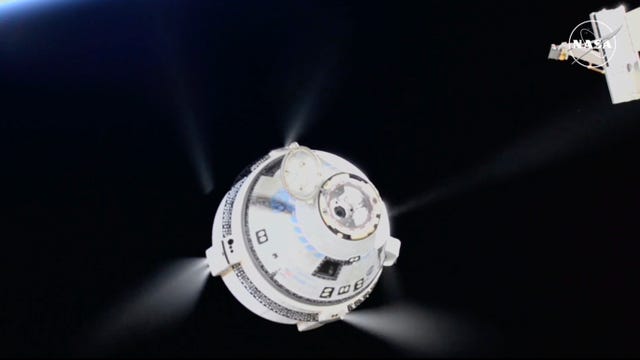Boeing’s Starliner capsule leaves ISS and heads home without astronauts
The return flight is expected to take six hours, with a nighttime touchdown in the New Mexico desert.

After months of turmoil over its safety, Boeing’s new astronaut capsule departed the International Space Station without its crew and headed back to Earth.
Nasa’s two test pilots stayed behind at the space station — their home until next year — as the Starliner capsule undocked from the orbiting laboratory.
The return flight is expected to take six hours, with a nighttime touchdown in the New Mexico desert.
“Bring her back to Earth. Good luck,” astronaut Suni Williams told Boeing’s Mission Control before Starliner departed.
Ms Williams and Butch Wilmore should have flown Starliner back to Earth in June, a week after launching in it. But thruster failures and helium leaks marred their ride to the space station.

SpaceX will bring the duo back in late February, stretching their original eight-day mission to more than eight months.
Boeing’s first astronaut flight caps a journey filled with delays and setbacks. After the space shuttles retired more than a decade ago, Nasa hired Boeing and SpaceX for orbital taxi service.
Boeing ran into so many problems on its first test flight with no one aboard in 2019 that it had to repeat it. The 2022 do-over uncovered even more flaws and the repair bill topped one billion dollars.
SpaceX’s crew ferry flight later this month will be its 10th for Nasa since 2020. The Dragon capsule will launch on the half-year expedition with only two astronauts since two seats are reserved for Mr Wilmore and Ms Williams for the return leg.
As veteran astronauts and retired Navy captains, Mr Wilmore and Ms Williams anticipated hurdles on the test flight. They have kept busy in space, helping with repairs and experiments.
The two are now full-time station crew members along with the seven others on board.
Even before the pair launched on June 5, Starliner’s propulsion system was leaking helium. The leak was small and thought to be isolated, but four more cropped up after lift-off.
Then five thrusters failed. Although four of the thrusters were recovered, it gave Nasa pause as to whether more malfunctions might hamper the capsule’s descent from orbit.
Boeing conducted numerous thruster tests in space and on the ground over the summer, and was convinced its spacecraft could safely bring Mr Wilmore and Ms Williams home. But Nasa disagreed and opted for SpaceX.
Flight controllers planned more test firings of the capsule’s thrusters following undocking. Engineers suspect the more the thrusters are fired, the hotter they become, causing protective seals to swell and obstruct the flow of propellant.
They will not be able to examine any of the parts; the section holding the thrusters will be ditched just before re-entry.
Nasa’s commercial crew programme manager Steve Stich said earlier this week that teams have been so focused on Starliner’s return that they’ve had no time to think about what is next for Boeing.
He said the space agency remains committed to having two competing US companies transporting astronauts.





